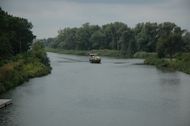Navigation: Home › The model › Model environment › Preprocessing
Preprocessing
In this step, the raw data required for modelling are suitably prepared and an initial parameter estimation is carried out. Data originating from different data sources have to be converted to the format required by the model and adjusted in their temporal and spatial resolutions. Three data types can be distinguished:
Geographic Data
They will be required to represent spatial structures and time-invariant characteristics of the modelled area. For a model application at least three basic data sets must be available: a digital elevation model (DEM), land use data and soil data. These data sets are the basis for generating other, derived data sets liek slopes, river network, sub-basins etc. WaSiM help tools like the topographical analysis tools Tanalys and the visualization tool ShowGrid can provide valuable assistance in this data preparation step.
Meteorological data
These data sets have to be provided to WaSiM as time series of station data (tables), regression or grid formats. The minimum requirement for a model application are precipitation and temperature data. Other useful variables are global radiation, wind speed, relative humidity, vapor pressure, and sunshine duration. The time-related WaSiM help tools support the conversion of such data sets to the format required by the model. Also, temporal and spatial interpolations and altitude dependent regressions can be carried out with certain tools. With Graphlines time series can be checked visually.
Hydrological data
In the first place, this are observed runoff data at hydrometric stations. They usually have to be converted into specific runoffs (e.g. in mm per time step like mm/h or mm/day) before they can be used in the model (but it's also possible to use them as runoff data in m3/s, depending on the measurement unit of modelled runoff, which can be switched to m3/s). Further hydrological data that may are available for model calibration are e.g. soil moisture, groundwater tables and reservoir management rules. The time-related WaSiM-Help Tools and Graphlines can be of valuable assistance in converting such data into WaSiM formats and in evaluating calibration results visually against observed data.

![[D]](../../templates/images/logos/flag-de.png)
![[E]](../../templates/images/logos/flag-en.png)



